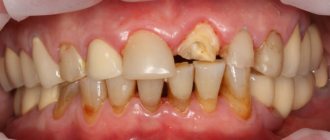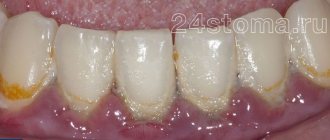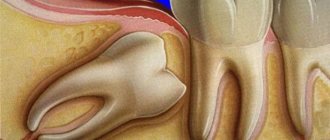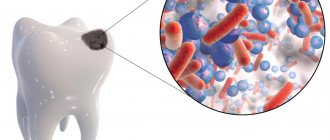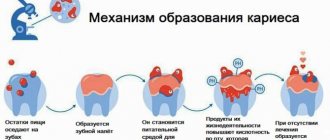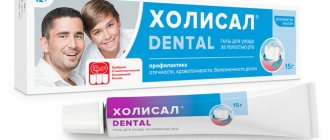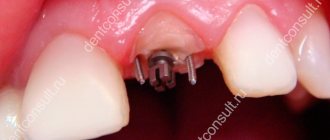Sign up for a consultation
+79252035555
Most often, people who feel a bad odor coming from their mouth seek advice from a dentist. Indeed, in 90% of cases of registered visits, examination reveals diseases of the teeth and gums that require treatment. After solving the problem, the bad smell stops bothering you. But sometimes patients who have crowns installed on their teeth begin to worry about the smell of rot coming from their mouth, and the source is clearly the tooth under the prosthesis.
Causes of odor under the crown
If the prosthesis is made and installed correctly, and the tooth is pre-treated or properly depulped, then no extraneous irritating odors will arise while wearing the crown - of course, with proper oral hygiene and regular dental examinations.
But it happens that either a crown is installed on an already defective tooth, or decay begins after the installation of the prosthesis for various reasons. Here the only possible way out is to eliminate the consequences by contacting the clinic.
The most common reasons why a prosthetic tooth begins to smell bad:
- Loose fit of the crown to the gum. If there is a gap between the edge of the denture and the mucous membrane, food particles will certainly get there. It is not possible to clean them with traditional means - a toothbrush and rinsing - so the substrate accumulates daily. Pathogenic bacteria begin to multiply on this biomass, rotting processes develop, and a specific smell appears.
- Depressurization of the connection between the crown and the tooth. This happens if the prosthesis is initially installed incorrectly or the cement is destroyed, and pathogenic microbes penetrate into the resulting cavities. As a result, inflammation of the gums occurs and even the development of secondary caries. All this contributes to the appearance of a characteristic unpleasant aroma from under the crown.
- Violation of the sealed connection with the tooth of the metal-ceramic crown . If, in addition, the crown is made on a metal base, if the cement layer is broken, air containing oxygen and saliva penetrate under the crown. In a humid environment, taking into account the pH of the salivary secretion, the metal of the crown undergoes oxidation, causing a bad odor. In addition, oxidized metal can become a source of irritation and allergic reactions of the gums.
- Lack of tooth protection after grinding. After preparing teeth for crowns, the final fixation of the crown does not occur immediately. Therefore, during the waiting period, the dentist puts a temporary prosthesis on the tooth stump or treats it with medical cement, excluding the penetration of bacteria into the tooth tissues that lack protection. If these steps are skipped for some reason, bacteria invariably settle in the tooth stump and cause decay under the permanent crown.
- Violation of the technology for manufacturing and installing the prosthesis. For various reasons (lack of proper equipment in the laboratory, low qualifications of the dental technician, little experience in prosthetics by the dentist, etc.), the crown is fixed on a tooth with irregularities. Gradually, injury to the tooth stump or soft tissue occurs with suppuration and the development of infection.
- Installing a crown on a tooth that required extraction . This doesn't happen very often. For example, it is necessary to install a bridge, and one of the supporting teeth must be removed. To save on implantation, the patient agrees to restore the defective tooth. As a result, after some time, the tooth is still destroyed, the tooth root is fractured, and the crown flies off. Therefore, if there is an indication for tooth extraction, then it should be removed and not used as a support for a crown.
- Lack of oral hygiene . Some dentures require careful care and cleaning of food debris. If simple steps are not taken, strains of pathogenic bacteria grow very quickly and putrefactive processes develop.
- Untreated caries and pulpitis at the stage of preparing the tooth for “crowning”. Hidden inside, diseases do not stop; on the contrary, they worsen. Therefore, it is first necessary to cure all dental caries.
- Poor quality depulpation. If the tooth canals are not completely filled, this causes the development of granuloma at the root apex. A granuloma, or cyst, is a cavity filled with pus. Also, the cause of the development of such inflammations is poor obturation of the root canals - with a loose arrangement of cement. Dr. Lopaeva’s clinic employs a professional dentist and endodontist who treats dental canals.
- Constant gum irritation. If the crown is poorly placed and regularly touches the gums, the mucous membrane responds with inflammation and swelling. The smell will also add severe pain. If there are no defects in the prosthesis, the doctor will trim the gum. If the defect is inherent in the product, you will have to install another crown.
Make an appointment with therapists at Dr. Lopaeva’s clinic
Make an appointment
Or call +7(985)532-21-01
Indications for use
The main reasons for the absence, for the elimination of which the dentist will suggest installing a crown on the tooth, include:
- destruction by 50% (both as a consequence of advanced caries and mechanical impact);
- the aesthetic side associated with the occurrence of chips, cracks, deterioration of color compared to the rest of the “brothers” in the series;
- damage to the coronal part (in other words, destruction of the installed prosthesis);
- critical abrasion - bruxism is a pathological disorder in which intervention will serve as protection for tissues.
Important! Bruxism is an involuntary grinding of teeth that occurs in people during nighttime sleep. First, the doctor will recommend undergoing a full diagnosis and treating the cause of the deviation, taking a course using a night guard, before direct placement.
Symptoms of tooth decay under the crown
The first and very obvious sign of irreversible changes occurring in the tooth is not pain, as many expect, but the smell. Sometimes pain is not felt at all, because the standard preparation of a tooth for prosthetics includes depulpation - removal of the neurovascular bundle. Therefore, the tooth loses sensitivity.
You should pay attention to the following points:
- First, an unpleasant taste appears in the oral cavity, and then a foul odor, which is noticed even by others. The smell cannot be masked for long with mouthwash or chewing gum.
- Dietary fiber gets clogged under the crown of the tooth and has to be removed from there. But if some large particles of food can be removed from the gap between the gum and the crown, then a large mass of them remains inside and begins to decompose.
- Darkening of the tooth under the crown.
- When you feel the prosthesis with your tongue, you feel a depression, a hole where food gets in.
- The gums become inflamed near the restored tooth and soft tissue swelling develops.
- If the tooth stump under the crown is alive, then there is noticeable pain.
All of these circumstances require an immediate visit to the clinic for treatment and indicate tooth decay with the formation of pus. Delay in this situation will lead to serious health consequences and considerable costs for medications and therapy. If you do not take quick action, the pus, accumulating inside under pressure, will cause the formation of a purulent cyst at the apex of the tooth root. Or it will break into soft tissues, turning into gumboil. To eliminate the abscess, you will have to endure a surgical procedure to open the abscess.
In addition, you should not think that pus in a tooth is a local nuisance. Together with the bloodstream, the infection spreads throughout the body, having a detrimental effect on the heart, lungs, joints, etc. It is no coincidence that in every dental clinic there will certainly be a poster warning that a rotten tooth is a source of constant inflammation of the ENT organs, osteomyelitis, blepharitis and other unpleasant diseases.
A neglected tooth left to rot under a crown is sometimes completely destroyed and has to be removed. Thus, a person gets a hole in his mouth that will need to be closed with expensive restorations: an implant or the installation of a bridge.
Habits that ruin your teeth every day
| Poor canal filling. If necessary, before installing a crown, the doctor removes the neurovascular bundle (pulp) and then fills the dental canals. If the canals are severely curved or the doctor does not have enough experience, then mistakes may be made during the procedure, which can cause pain in the tooth. These include:
It is important that before and after canal treatment the dentist takes targeted photographs - this is the only way to identify all the shortcomings | |
| Poor quality materials. Poor filling material begins to settle and does not adhere so tightly to the walls of the tooth, thereby eliminating the tightness. Sometimes the filling cracks, and through these micro-cracks an infection enters the tooth, which causes the development of caries under the crown. | |
| Perforation of the root wall. If the roots are severely bent, the doctor may not calculate the force of pressure on the drill. As a result, the channel is drilled through. If the error is not corrected, the infection can penetrate into the tooth from below and lead to caries. Perforation can also occur if the pin is not installed correctly. | |
| Fracture of the instrument in the canal. The disposable root canal drill is very thin and fragile. If the channels are strongly curved, then with strong rotation and awkward movement of the doctor, the tip of the instrument may break off. There are other reasons why a foreign body remains in the canal:
| |
| We recommend taking a panoramic photo of the jaw (OPTG) before installing a crown. It will allow you to timely detect deformation of the canals, the presence of inflammation and particles of instruments in the canal. | |
| Incorrect crown size. There are several reasons for this: an error during taking impressions; deformation of the material from which the impression is made; the crown was installed without fitting;; The dental technician did not correct the defects after trying on the crown. | |
| Error in crown installation. The crown does not fit tightly to the tooth, or it is installed without taking into account the bite - it can be too high or low - this injures the antagonist teeth. | |
What to do to get rid of the smell
When an unpleasant odor occurs in the mouth, a person most often realizes that the cause is tooth decay, but tries to deal with the problem on his own: rinses the mouth with various pharmaceutical products or infusions made according to folk recipes, tries to kill the bad odor with mouth odorants or chewing gum. If the tooth responds with pain, the person takes painkillers. As a result, tissue decay continues. Then the pain goes away - because the nerve endings die, and the patient believes that a cure has occurred.
The result is tooth loss. It is especially unpleasant if the crown covered a gap in the front row. Now the patient will have to install an implant and crown to maintain the aesthetics of the smile. Therefore, no matter how great the temptation is to let things slide or attempt to cure yourself, remember: dental diseases, especially tooth decay under the crown, cannot be cured at home. All of them require the intervention of a medical professional.
Before visiting the clinic, you can rinse your mouth with tinctures of herbs that have anti-inflammatory properties: a decoction of chamomile, oak bark, calendula. In the hospital, the dentist will determine the stage of tooth decay and perform a series of appropriate procedures. A sick but strong tooth is cured, a damaged one is removed. If there is no inflammation, and the cause of the smell is plaque accumulated in the space between the tooth and the crown, the doctor will clean the tooth of dirt. The crown is then subjected to additional processing to adjust the size and ensure a tight fit to the stump. After this, the prosthesis is fixed with sealing cement.
To ensure hygiene in the oral cavity, if there are one or more dentures, a good solution seems to be the purchase of an irrigator - a device that removes dirt and plaque with a disinfectant solution supplied under pressure. Even hard-to-reach areas that no toothbrush can reach can be cleaned.
Dentists also recommend using dental floss and rinsing your mouth with clean water every time after eating. Various agents with an antibacterial effect are used to rinse the mouth. They are not able to clean plaque from microscopic cracks and gaps between the prosthesis and the tooth stump, but they successfully destroy pathogenic microbes, stopping their life cycle.
If the destruction of cement, loosening of the crown or weakening of the pin occurs during the treatment guarantee, then all actions to restore the quality of the prosthesis are carried out free of charge. Therefore, it is important for the patient to monitor the crown and, if in doubt, contact the clinic where the restoration was made in time.
Install veneers without grinding Luxneers teeth at Dr. Lopaeva’s clinic
Find out more about Luxneers
When you need to see a doctor urgently
Urgent medical attention is necessary if tooth pain under the crown is accompanied by the following symptoms:
- sore, swollen, reddened gums are a sign of inflammation of the periodontal tissues; It is better not to start this process, it can spread, causing various complications;
- increase in body temperature - a slight increase indicates the presence of an infectious-inflammatory process in the tissues; if a high fever appears, then most likely the process has acquired a purulent character; it is very dangerous;
- facial asymmetry - may be a consequence of tissue swelling with severe inflammation of soft tissues after prosthetics; it also occurs with injury or inflammation of the facial nerve associated with various dental procedures; If not treated promptly, facial asymmetry related to the facial nerve can last a lifetime.
Treatment options for a tooth under a crown
When contacting the clinic, the dentist determines how great the changes are in the dental tissues, and based on the results of the examination, prescribes treatment.
- If the tooth stump has not undergone any changes and rot has not affected it, the doctor cleans out the accumulated food debris from under the crown. Then a new prosthesis or an old one, but corrected, is installed.
- If healthy roots remain, the crown is placed on the stump tab. This device is made in a dental laboratory from an impression and is a structure with peculiar “legs” that are designed to fix the inlay in the tooth canals. And a crown is attached on top.
- If both the upper and root parts of the tooth have rotted, the remains are removed from the mouth and periodontitis is treated. The patient then has to decide on how to restore the tooth. There are two options: implantation or installation of a bridge.
When contacting a clinic for initial prosthetics, it is important to find out at the stage of monitoring institutions whether the clinic provides a guarantee for the treatment provided. If there is a guarantee, then in case of medical errors, treatment and re-restoration are carried out free of charge for the patient.
Pros of ceramics
Engineers and chemists of large concerns for the production of dental materials (mostly German) are very hardworking and purposeful people. This is not a common stamp - I was convinced of this from my own experience, watching the evolution of ceramic crowns from Ivoclar Vivadent for 15 years. This is not an advertisement - this name means little to the average person, and dentists do not trust advertising. Over the years, the company has come a long way from really fragile crowns in the 2000s (the instructions said so - only for front teeth, with a bunch of contraindications) to the modern material e.Max (Imax, emphasis on the letter I), which in most cases regions is crowding out the former grandee - zirconium dioxide.
Let's list what makes Emax so remarkable:
- Strength. Allows you to make not only crowns, but also bridges. Not only for front teeth, but for any teeth. There is enough strength to spare.
- A huge selection of colors, transparency options , the possibility of individualization either by simple painting or by applying additional layers of ceramics (this is the finest work on the verge of craft and art, in some cases up to 15 layers of ceramics are used, achieving incredible naturalness).
- Possibility of manufacturing individual implant abutments. The abutment is the outer part of the implant; the crown rests on it. There are two options for their use - standard titanium abutments manufactured at the factory (there is no time for aesthetics here, the strength or complexity of the design is important) or individual abutments. If you make such an abutment from Imax material, the crown on the implant (by the way, it can also be Imax) will be more aesthetically pleasing.
- Emax has brought digital technology directly to the dental chair. Now the doctor can make crowns on his own and in one visit . The aesthetics and strength are the same, the accuracy is higher - the human factor is reduced to a minimum. This technology is called CEREC (Cerek, emphasis on the first syllable), in conjunction with modern ceramic materials, it is incredibly convenient for both the doctor and the patient.
- The crown is bonded to the tooth (dentists call this bonding) by creating a chemical bond between the ceramic, adhesive luting cement and the tooth tissue. This connection is absolutely sealed and durable.
How to care for a crown
Both the dentist and the patient are interested in the crown serving its intended purpose for a long time. To increase the period of good functioning of the prosthesis, a person will need additional care products, because a standard toothbrush is not able to clean the removable element:
- The beam brush is designed to clean the internal surfaces of the prosthesis;
- The interproximal brush on the head contains a special brush that easily reaches hard-to-reach places on the lateral surfaces of the prosthesis, cleans the areas between the crown and adjacent teeth;
- Floss is required for regular cleaning of interdental crevices;
- If the household has an irrigator, it will be a constantly in demand device, because only it can clean the areas in the cervical fastenings of crowns.
Rules for caring for fixed dentures
High-quality care of crowns in compliance with all hygienic rules can significantly extend the service life of the product.
Since a regular toothbrush is not able to fully clean all hard-to-reach places, additional care products are used to better treat teeth and dentures.
Dental floss (floss). This is a special thread made of nylon, silk, acetate fibers with a flat or round cross-section, designed to clean interdental spaces. To enhance the effect, they are often impregnated with antiseptics.
Floss - disposable toothpicks with a thread on a frame are used for the same purposes as floss.
Bundle brush . The interdental spaces are cleaned using a brush-brush with many long bristles. Dentists recommend alternating cleaning the spaces between teeth with brushes and dental floss, since some of them (floss) are better suited for narrow gaps, and a tuft brush does an excellent job of cleaning wide gaps.
An interproximal brush with a brush is designed to treat hard-to-reach areas between the crown and adjacent teeth.
An irrigator is a device for cleaning the oral cavity using a water jet supplied under pressure. A pulsating stream of water penetrates into the most inaccessible places, cleanses the surface of teeth and artificial dentures from plaque and food debris in the gum pockets and interdental spaces.
Dentists do not recommend using wooden toothpicks at all. Wood particles get stuck between the teeth, begin to rot and cause inflammation. In addition, toothpicks can easily injure your gums without even noticing it.
What to do if the tooth under the crown has completely rotted
It happens that a tooth rots because the crown was initially installed on a defective stump. And sometimes the person himself is to blame for this development of events, because he delayed contacting the doctor.
If the tooth has at least its roots preserved, it is possible to restore the tooth with a special device - a stump insert. The structure is made of ceramic or metal and has branches according to the number of roots. These processes are fixed in the root canals to a third of their depth. The top of the stump tab is intended to strengthen the crown on it.
Often gold or silver is used to cast the stump insert. The first material is preferable because it shines through the crown with a warm yellow color. This shade is similar to the color of natural enamel and is not perceived as foreign. The silver tab has antibacterial properties, but the cold shade affects the visual pigmentation of the gums. This will bother the patient, especially if the tooth is located in the front.
If the roots are rotten, the stump insert will not hold in them. The remaining tooth is removed and restored with an implant or prosthetics.
If the adjacent teeth, which will play the role of supporting teeth, are preserved, it is possible to install a fixed bridge prosthesis. Removable dentures are also common: nylon, acrylic. Here you will have to focus on the amount that the patient is able to pay for this or that method of dental restoration, and the aesthetics that he prefers. During the consultation, the doctor will offer to look at the options for finished products in the photo, and the person will choose the appropriate type of product.
When it cannot be installed
Unfortunately, in medicine there is no universal treatment method that would suit everyone without exception. Before placing a crown on a tooth, discuss possible contraindications with your doctor:
- the presence of inflammatory processes in the acute stage (common stomatitis, periodontitis, pulpitis and other diseases, for example, periodontal disease and gingivitis);
- malocclusion.
Varieties
The difference in tissues from which dental crowns are created depends on the type of teeth:
- More attention is paid to the front teeth; it is important for patients to obtain an aesthetically pleasing result with a natural color, since they are the focus of attention when communicating;
- on chewing teeth, it is possible to use cheap and simple materials, especially when located far away; however, the structure must be durable to bear the chewing load.
Additional information: children of the nineties remember the golden bridges that adults flaunted, including on the visible row - a symbol of prosperity and wealth. Professional dentistry has long moved away from “jewelry” in the production of prosthetics, however, according to reviews on the Internet, this method of prosthetics is still found in settlements remote from the center.
Metal
Metal is suitable for crowns on chewing teeth because of its strength to withstand the daily stress of eating food. An older and less applicable method of tooth replacement.
Titanium construction is a hypoallergenic installation that causes a lower percentage of rejection.
The lack of visual aesthetics reduces the popularity of such systems, however, customers are attracted by the low cost and durability.
Metal ceramics
A metal-ceramic tooth crown is a frame made of precious metals (gold, platinum, palladium) and an outer ceramic “case” to give a natural look to the new denture.
Porcelain veneer is selected in accordance with the color of the dentition, so as not to differ from its neighbors and at the same time be highly durable and wearable for up to 15 years.
A popular type of restoration that provides a guaranteed result at a relatively low cost.
Advantages:
- durability;
- suitable for 99% of those who seek help;
- safety due to hypoallergenic raw materials.
Only ceramics
A ceramic crown is suitable for fixing to a tooth in the smile area - a place where a person does not make chewing movements, since ceramics are strong, but not strong enough for constant pressure.
The structure on the metal frame “shines through” the metal, thereby increasing the yellowness and reducing the beauty of the altered tooth. When installed without a metal structure, there will be nothing to “shine through”.
Metal-based plastic
This replacement of a lost tooth is suitable only for temporary use, for example, during the production of a permanent crown, as it has a number of obvious disadvantages:
- visibility of metal through the plastic “cap”;
- loss of original white color;
- fragility under constant exposure.
However, an affordable price and a shelf life of one to three years ensure a percentage of demand.
This type of material also includes a completely plastic crown, which is also intended for temporary wear. The advantages are similar: low costs, easier installation.
Zirconium
The most expensive orthopedic structures are made from zirconium dioxide or oxide, which has a bright white color and is as strong as devices with a metal base.
Due to its unique combination of properties, it is suitable for visible teeth as well as for the back row. In addition, they are not translucent and completely hypoallergenic.
Thus, to understand which dental crowns are better, it is necessary to understand the patient’s goals, financial capabilities and the location of the destroyed tooth.
Glass ceramics Emax
The desire for an aesthetically pleasing appearance of teeth pushes specialists to search for new materials for crowns. The Ivoclar Vivadent company from Liechtenstein offers an alternative to the usual raw materials - glass ceramics - an option for metal-free prosthetics (including veneers and bridges up to three units long).
The structure is 70% lithium disilicate, the advantages of which are:
- maximum resemblance to the enamel of real teeth;
- increased light transmittance (glass matrix);
- matching the color and texture of neighboring teeth, which makes it invisible in the dentition;
- wide selection of tones and shades.
In terms of its properties, glass ceramics outperforms its counterparts made of zirconium dioxide, therefore it is most applicable to the visible part of the jaw.
Despite the delicate level of design, it is highly durable due to its structure (pressed E-max Press or monolithic E-max Cad ceramics). Zirconium and metal ceramics tend to wear out over time, which inevitably leads to chips in more than 6% of patients.
E-max press is produced by pressing at high pressure and temperature.
Glass ceramics are suitable for:
- installation on single teeth, regardless of location (withstands chewing load);
- bridges up to three units even for the front teeth;
- installation of veneers and lumineers;
- high transparency enamel.
Contraindications:
- not suitable for distant chewing teeth (the last support is attached to a maximum of the fifth tooth);
- prohibited in the presence of bruxism;
- This is not possible if the tooth is of a dark color.
In addition, if more than 3 teeth are missing, installation of Emax is impossible, since the load on the chewing teeth will be distributed incorrectly (mainly on the preserved natural ones), which will lead to the destruction of the crowns, malocclusion and the location of the teeth.
Metal-free glass ceramics will cost the user much more than zirconium and metal-ceramic analogues, this is due to the unique design properties that make it possible to achieve one hundred percent coincidence and naturalness, therefore it is suitable for connoisseurs of real aesthetics.
What does the process involve?
After the patient chooses the material for the future denture, he will have to go through a preparatory stage, which includes:
- Consultation with an orthopedic dentist - during which they will conduct a detailed examination of the oral cavity for the presence of carious disease that prevents further work; at the first appointment, they will draw up a treatment plan and determine how much a crown per tooth costs;
Note! At the beginning, the doctor must include x-rays to determine the “scale of the disaster” and tissue destruction for an accurate diagnosis and determine the possibility of installing a prosthesis. Our clinic offers all types of x-ray examinations: targeted x-ray, panoramic dental x-ray, computed tomography.
- Sanitation - treatment of caries if present, getting rid of stomatitis and bruxism; in addition, dentists recommend undergoing hygienic treatment to avoid the possibility of introducing bacteria;
- If necessary, the tooth canals are cleaned;
- Tooth grinding - removal of a layer of the tooth (from 1.3 to 2 mm depending on the tissue of the structure), is carried out under local anesthesia, painlessly and takes about an hour; This procedure is also possible under a microscope, in this case fractions of a millimeter of tooth tissue are removed and accuracy increases;
- Taking impressions - for this purpose, an impression mass is used to make an impression of both jaws, or a scan of all teeth;
- Manufacturing of crowns - in a dental laboratory in accordance with the impressions obtained;
- The use of a temporary crown made of plastic is carried out especially on prominent teeth, so that the patient feels confident while the final crown is being made.
Next, after the crowns pass the control of the dental technician, the main stage occurs. During this period, the patient needs to listen to the sensations and in case of even minor inconvenience caused by the crown, inform the attending physician about this, at this stage corrections can be made.
What to do if a crown falls out
The crown sometimes flies off the tooth not only due to the complete destruction of the stump tissue. Sometimes the prosthesis comes off because it is poorly fixed to the cement: the material has collapsed or the adhesion to the crown material has been lost.
Often people do not attach importance to this, installing the crown in place on their own each time. However, such neglect is fraught with rotting of the tooth under the crown or accidental swallowing of the prosthesis. Therefore, you definitely need to contact the clinic to correct fixation deficiencies.
If the crown falls out along with the pin or stump, the conclusion is clear - the doctor did not properly strengthen the structure inside the tooth. Particular care must be taken to follow the technology when working with a stump insert: after it is placed in the root canals of the tooth, adjustment of the structure with a drill is possible only after 24 hours. This time is necessary for the cement to harden.
Inexperienced dentists often begin adjusting the inlay 10-15 minutes after installation. The cement breaks down before it has time to harden. Of course, soon the entire structure falls out into the oral cavity. If the crown is in satisfactory shape, a professional dentist can quickly return it to its place if you contact him without delay.
How to relieve pain
The tooth under the crown can get sick at any time. How to relieve symptoms if it is not possible to see a doctor soon?
- Painkillers (Ketanov, Nise, Ibuprofen, etc.)
- Rinse your mouth with a solution of baking soda and salt.
- Rinse your mouth with a decoction of chamomile or sage
Remember that pain is the body's signal for help. Constantly ignoring and drowning out the pain with improvised means can worsen the problem, and then the only solution will be tooth extraction.
Causes of blood taste in mouth
Sometimes, in addition to the unpleasant smell, the patient is also bothered by the taste of blood in the mouth. Possible reasons for such sensations:
- Gingivitis develops, inflammation of the gums around the crown. The mucous membrane can become inflamed for various reasons. For example, the prosthesis fits tightly to the soft tissues, constantly rubbing them.
- The crown scratches and injures the adjacent gum. Blood is released, infection enters the wound, the mucous membrane becomes inflamed and bleeds. This only happens if the crown is not fixed correctly or if its dimensions are violated. Needs a complete refurbishment.
- Bleeding can cause unsatisfactory treatment of the tooth before placing a prosthesis. Poor filling of canals or incomplete removal of the pulp invariably causes inflammation and accumulation of purulent masses. Tissues are destroyed with the release of blood.
The appearance of blood discharge in the oral cavity should not be ignored. Pathogens easily penetrate an open wound, causing great damage to human health.
Preventive crown care
In order not to provoke the accumulation of masses under the crown and cause tooth decay, it is necessary to maintain oral hygiene. A crown is an artificial structure and will require more care.
- Brush your teeth twice a day, including using special brushes for caring for dentures.
- Rinse your mouth after every meal.
- Floss regularly.
- Use toothpicks only when necessary. This is not at all a means of maintaining dental hygiene! Picking with a wooden stick, expanding cavities in teeth and crowns, is contraindicated.
If you have already had the sad experience of tooth decay under a denture, pay more attention to the alarm bells: pain under the crown, bad smell, taste of blood in your mouth. Make an appointment with a dentist; timely treatment will be shorter and cheaper than treatment for a neglected tooth.
If you realize that the tooth has begun to rot, remember that the process is irreversible. It will not be possible to cure inflammation with home methods. You should not wait until there is severe pain or the crown falls out in your sleep, with the risk of suffocation. A diagnosis from a doctor will help you cope with the problem.
Make an appointment at Dr. Lopaeva's clinic
Make an appointment
Or call +7(985)532-21-01
Why a tooth can rot under a crown, what needs to be done and where to go
NuCalm – dental treatment without fear and stress, relaxation without medications
A tooth hurts under a crown, where to go in Moscow
Acute toothache where to go in Moscow
How is the treatment carried out?
Of course, the simplest option is this: the doctor removes the crown, treats the tooth, and then installs the crown again. But the disadvantage of this method is that the patient will have to pay again for all orthopedic work, including the crown.
However, today you can go a different route, which is offered by some dentists. In this case, the tooth is treated without removing the structure. The doctor makes a hole through which he performs the necessary manipulations, and then seals it.
Before treating a tooth, a photograph is always taken under the crown. If the problem is not detected on the diagnostic image, then the crown will need to be removed to determine the cause of the pain.
Treatment of a living tooth
If the cause is caries, then treatment; most often performed through the crown. Main signs: pain is sharp and severe, the tooth reacts to hot and cold.
If the reason is a violation of the fixation of the crown, then the crown is removed, medicine is applied to the ground tooth, and then the crown is put back.
Treatment of a pulpless tooth
Signs: aching pain, accompanied by pulsation in the temple and ear. Treatment is carried out both with and without crown removal - it depends on the presence of a pin and the cause of pain (periodontitis, a fragment of an instrument in the root, etc.).
